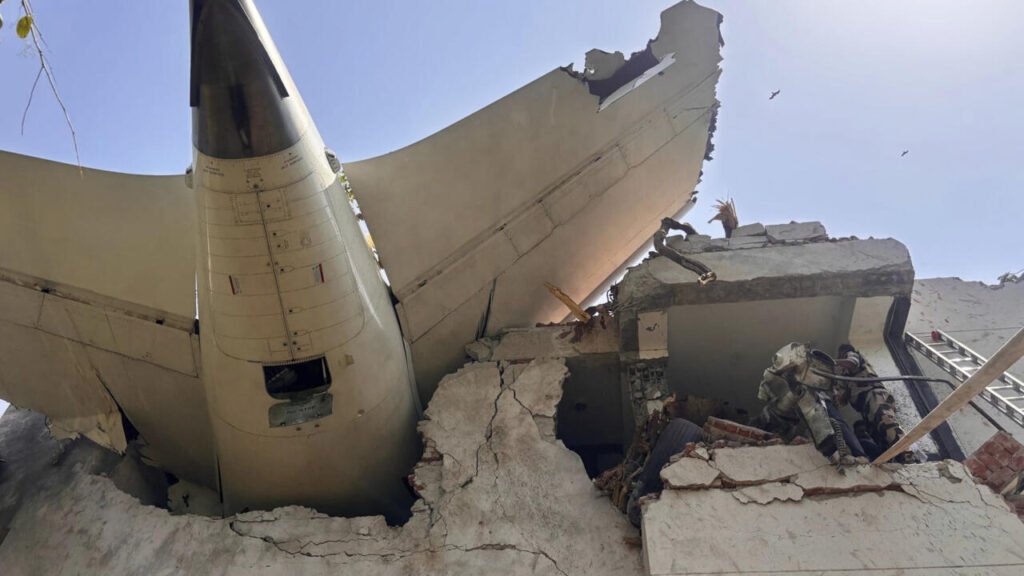Air India Flight AI-171 Crash: New Video Suggests Possible Cause Behind Tragic Incident That Killed 270 Passengers
A devastating tragedy unfolded in India on June 15, when Air India Flight AI-171 crashed shortly after taking off from Ahmedabad, killing all 270 people on board. The nation and the world were left in shock as families mourned their loved ones and investigators rushed to find out what went wrong.
Now, a newly surfaced video may offer a critical clue into the possible cause of this horrific aviation disaster. Captured by a bystander just moments before the crash, the video shows a small, fast-spinning grey object emerging from underneath the aircraft. Aviation experts believe this object could be a major piece of the puzzle.passenger
What the Video Reveals: A Mysterious Object Appears
The footage, recorded on a mobile phone by a local resident near the airport, shows Flight AI-171 ascending into the sky for what appeared to be a routine takeoff. However, within seconds, a small grey object appears beneath the fuselage.passenger
At first glance, the object might look insignificant to an untrained eye, but aviation professionals immediately noticed something strange. Captain Steve, a former commercial airline pilot and seasoned aviation analyst, weighed in on the footage. He believes the object is the Ram Air Turbine (RAT), a critical emergency device found in commercial aircraft.passenger
“This is not something that should be visible during normal operations,” said Captain Steve in a video statement. “The Ram Air Turbine only deploys when the aircraft experiences a total loss of engine power or a complete hydraulic system failure.”
The fact that the RAT appeared just seconds after the plane lifted off raises serious concerns. Captain Steve suggests this could point to a catastrophic mechanical failure almost immediately after takeoff.passenger
Understanding the Ram Air Turbine (RAT)
The Ram Air Turbine is a backup system designed for rare but extremely dangerous situations. Typically hidden within the aircraft’s body, it deploys only in emergencies. Its job is to generate power using airspeed, helping restore essential systems such as hydraulics and limited electrical supply in the event of a total system failure.passenger
While the RAT is a lifesaving tool in emergencies, its appearance in this case may be a red flag.passenger
According to Captain Steve, “The RAT being deployed this early into the flight, before the aircraft had even stabilized its climb, strongly indicates that something went very wrong right after takeoff. Either both engines failed or a major electrical issue occurred.”passenger
Mayday Call Adds to Mystery
Adding to the disturbing evidence, flight logs reveal that the cockpit crew of AI-171 issued a “Mayday” distress signal just seconds after liftoff. In aviation, a “Mayday” call is used only in life-threatening emergencies and signifies that the crew is facing an extremely critical situation.
This timeline supports the theory that the aircraft suffered a major failure within moments of becoming airborne. Several reports suggest the plane struggled to gain altitude before banking sharply and then plunging towards the ground.
Eyewitnesses near the crash site reported hearing unusual engine noises and seeing black smoke trailing from the aircraft just before impact.
“I was looking up at the plane, and I heard a loud thudding noise,” said Ramesh Patel, a resident living near the crash site. “It didn’t sound right. The engines didn’t sound normal, and then it just turned and went down.”
Possible Cause: Dual Engine Failure?
While it is too early for investigators to reach a final conclusion, several aviation experts, including Captain Steve, believe a dual engine failure is a strong possibility. Dual engine failures are extremely rare, especially right after takeoff, but they are not impossible.
“Modern aircraft are designed to handle one engine failure,” explained Captain Steve. “But when both engines fail together, especially during takeoff when the plane is at low altitude and high weight, the pilots have very little time to react.”
If both engines indeed failed, it would explain the RAT deployment, the Mayday call, and the rapid loss of control.
Investigators are now analyzing flight data recorders (commonly known as black boxes), which were recovered from the crash site. These devices will provide crucial data on the aircraft’s systems, engine performance, and cockpit communications during those final, terrifying moments.
Other Possible Scenarios Being Investigated
While dual engine failure is currently a leading theory, authorities have not ruled out other possibilities.
-
Fuel Contamination or Starvation: One possibility is that the plane experienced fuel system issues, such as contaminated fuel or failure of fuel pumps, which could starve the engines and lead to failure.
-
Bird Strike: Large birds being sucked into engines during takeoff have been known to cause engine failures. However, there is no confirmed evidence of a bird strike in this case yet.
-
Electrical System Failure: A complete electrical failure could also trigger RAT deployment and affect engine performance or control systems.
-
Hydraulic Failure: A full hydraulic system failure could make it impossible for pilots to control the aircraft, but this alone wouldn’t normally cause engine shutdown unless accompanied by other malfunctions.
-
Sabotage or Security Breach: Though no evidence currently points in this direction, investigators are required to rule out every possibility, including human interference or terrorism.
The Aircraft: Age and History
Flight AI-171 was operating a Boeing 787 Dreamliner, considered one of the most advanced and safest aircraft in commercial aviation. However, this particular aircraft had completed nearly 15 years of service.
Though Air India has maintained a good safety record overall, critics have raised questions about maintenance standards and aging fleet issues. It remains unclear whether maintenance history or mechanical wear played a role in this tragedy.
Passenger List and International Impact
The crash claimed the lives of 270 individuals, including men, women, and children. Among them were 38 foreign nationals, including citizens from the UK, UAE, Canada, and Australia. The tragedy has sparked condolences from around the world.
Air India issued a statement expressing deep sorrow over the loss of life and vowed full cooperation with investigative authorities.
“Our hearts go out to the families of the victims,” the airline said. “We are fully committed to supporting the investigation and ensuring full transparency in the process.”
State Bank of Pakistan Forecasts Rs. 2.4 Trillion Profit for FY25
Read This Artical
Public Reaction and Demands for Answers
The heartbreaking crash has triggered outrage and grief across India and abroad. Families of the victims are demanding accountability, and aviation authorities are under intense pressure to provide clear answers.
Social media has been flooded with messages of sympathy, tributes, and calls for better aviation safety. Hashtags like #AI171Crash and #JusticeForAI171Victims have been trending across Twitter and Instagram.
“I lost my brother and his entire family in this crash,” said one grieving relative. “We want to know how such a disaster could happen. Someone has to answer.”
What Happens Next: Investigation and Safety Measures
India’s Directorate General of Civil Aviation (DGCA), along with representatives from Boeing and international aviation safety agencies, is leading the investigation. The black boxes have been sent for urgent analysis, and a preliminary report is expected within weeks.
Aviation Minister Jyotiraditya Scindia assured the public that the government is taking all steps to ensure transparency and safety.
“This is a national tragedy, and we will not rest until we understand the full truth,” he said. “We are committed to taking corrective action wherever necessary.”
Air India has also grounded several aircraft from the same fleet for inspection as a precautionary measure. Maintenance records, crew training logs, and last-minute technical reports are all being thoroughly reviewed.
Lessons from the Past
This is not the first time a Ram Air Turbine has been spotted during or after a crash. In the famous case of Air Transat Flight 236 in 2001, the RAT deployed after fuel exhaustion caused both engines to fail mid-flight. The pilots managed to glide the plane to safety, saving all 306 people on board.
Unfortunately, Flight AI-171 did not have enough altitude or time to recover.
Experts believe the presence of the RAT in this case may prove just as crucial in helping investigators reconstruct the moments leading up to the crash.
Understanding the Ram Air Turbine (RAT)
The Ram Air Turbine is a backup system designed for rare but extremely dangerous situations. Typically hidden within the aircraft’s body, it deploys only in emergencies. Its job is to generate power using airspeed, helping restore essential systems such as hydraulics and limited electrical supply in the event of a total system failure.
While the RAT is a lifesaving tool in emergencies, its appearance in this case may be a red flag.
According to Captain Steve, “The RAT being deployed this early into the flight, before the aircraft had even stabilized its climb, strongly indicates that something went very wrong right after takeoff. Either both engines failed or a major electrical issue occurred.
Final Thoughts: A Nation in Mourning
As India grapples with the aftermath of this tragic event, the investigation is more than just a technical procedure—it’s a path toward closure for hundreds of grieving families.
The world watches closely as investigators analyze the wreckage, listen to the cockpit voice recorder, and examine every second of flight data. Whether it was a mechanical failure, human error, or a combination of events, uncovering the truth behind AI-171 is essential to preventing similar tragedies in the future.
Until then, the memory of those 270 lives lost will remain etched in the hearts of their loved ones—and serve as a solemn reminder of the importance of aviation safety in every corner of the world.Tragedy




